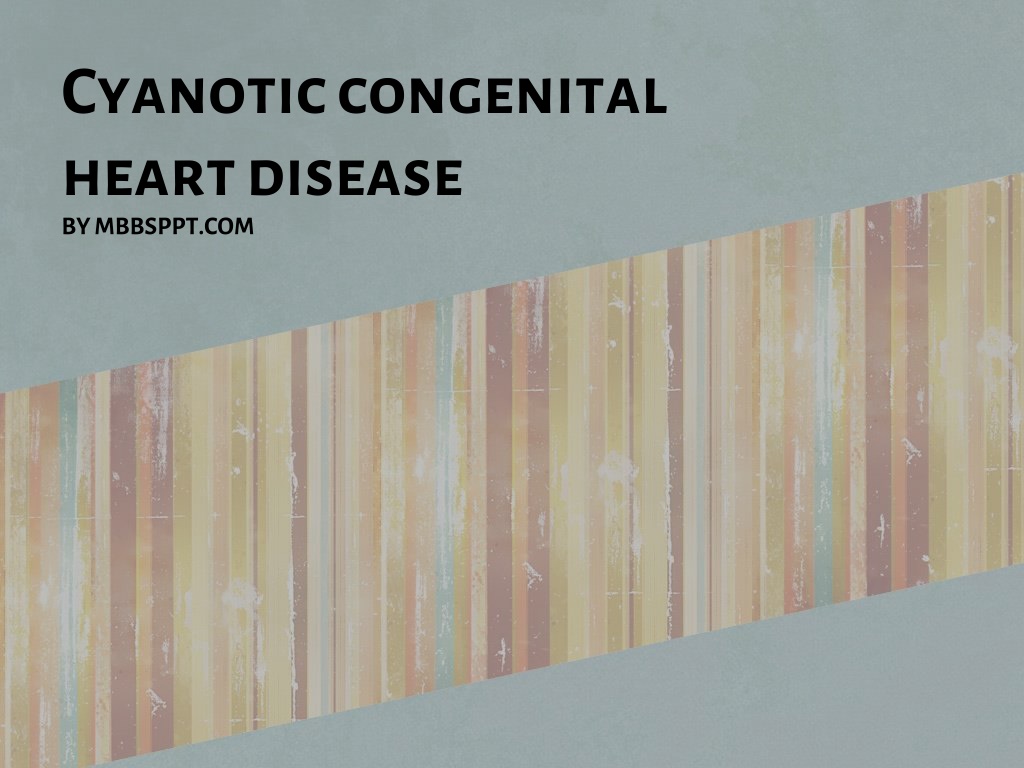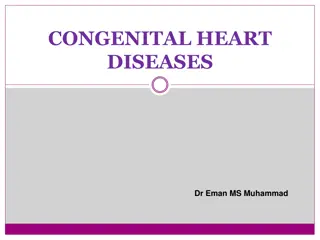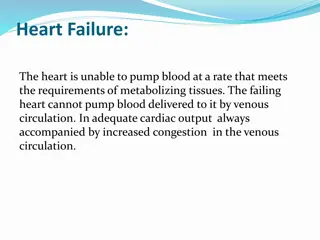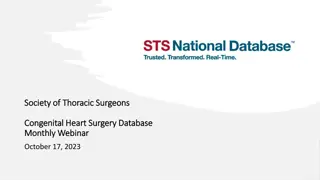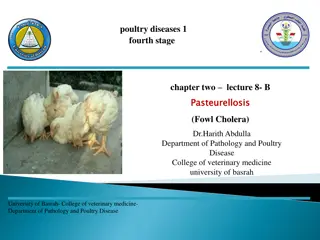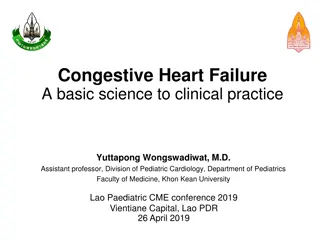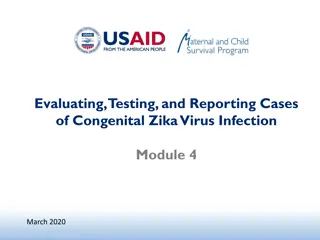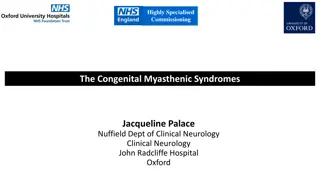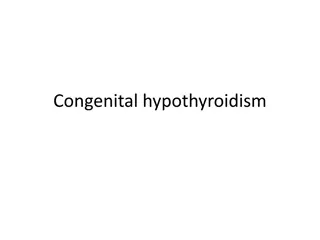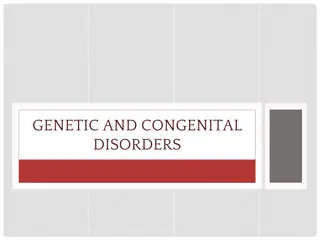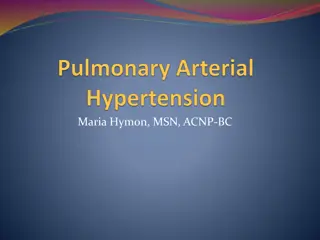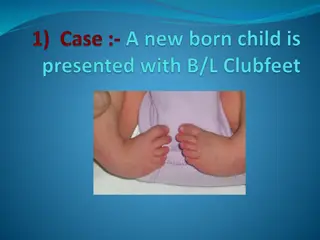Causes and features of cyanotic congenital heart disease
This informative content covers the causes and features of cyanotic congenital heart disease, including central cyanosis due to congenital heart diseases like Tetralogy of Fallot, pulmonary atresia, Ebstein anomaly, and more. It also discusses non-cardiac causes of cyanosis related to lung diseases, CNS depression, and miscellaneous conditions. Radiological features, ECG findings, blood gas responses to 100% O2, and the 5 most common cyanotic lesions of newborns are detailed.
Download Presentation

Please find below an Image/Link to download the presentation.
The content on the website is provided AS IS for your information and personal use only. It may not be sold, licensed, or shared on other websites without obtaining consent from the author. Download presentation by click this link. If you encounter any issues during the download, it is possible that the publisher has removed the file from their server.
E N D
Presentation Transcript
Cyanotic congenital heart disease BY MBBSPPT.COM
CAUSES OF CENTRAL CYANAOSIS A. Congenital Heart Disease 1) Cyanosis with PBF 2) Cyanosis with PBF a) TOF b) Pulm. Atresia b) DORV without PS c) Tricuspid Atresia c) TAPVC d) Critical PS e) DORV with PS f) Ebsteinanomaly arteriosus a) D-TGA d) Truncus
CAUSES OF CENTRAL CYANAOSIS B. LUNG DISEASE D. CNS DEPRESSION a) b) c) d) e) RDS Pneumonia Pneumothorax c) Heavy maternal sedation Diaphragmatic hernia T.E.Fistula a) IVH b) Perinatal asphyxia C. PERSISTENT PULMONARY HYPERTENSION E. MISCELLANOUS a) shock & sepsis b) Hypoglycemia c) Methemoglobinemia d) Neuromuscular conditions ( Werdnig Hoffman)
RADIOLOGICAL FEATURES CXR may exclude non cardiac causes of cyanosis e.g. RDS. . Meconiumaspiration,Diaphgramatichernia,Pneumothorax Pulmonary Vascular Markings Decreased Increased Heart Size Heart Size Normal Increased Increased ( Boot shaped ) ( Wall-to-Wall ) TOF Ebstein ( egg-on-end ) D-TGA Abdominal Situs Aortic Arch \ Mediastinum
ECG RV dominance on ECG is normal in the newborn. Left axis deviation with LVH strongly suggests: Tricuspid Atresia. Left axis deviation in a newborn may also indicate: AV canal ( However , AV canal is usually an acyanoticform of heart disease).
Blood gases & response to 100% O2 Always try to obtain ABG from RIGHT radial artery. Low PH: may indicate sepsis, circulatory shock or severe hypoxia High pCO2: may indicate CNS or pulmonary disease. HyperoxiaTest: 100% O2 by hood for 10 minutes. pO2 > 150 torr= pulmonary disease. pO2 < 100 torr=cyanotic heart disease
5 Ts Most common cyanotic lesions of the newborn Tetralogyof Fallot Transposition of the Great Arteries TruncusArteriosus Total Anomalous Venous Return Tricuspid Atresia
Tetralogy of Fallot Commonest CCHD >2 yr of age 1. High Nonrestrictive VSD 1. RVOT Obstruction 2. RVH 3. Overriding aorta
Embryology Anterocephalad malalignement of infundibular(outlet) septum with trabecular septum(muscular) RVOT obstruction Arrested development of bulbar cordis PS/infundibular stenosis Incomplete rotation of aortic-pulmonary septum dextraposition of aorta Failure of aortic-pulmonary septum to fuse with interventricular septum High VSD
Associated defects Rt sided aortic arch 25% cases Anomalous origin of coronary art. 2-10% cases ASD 15% cases Two variants : pentalogyand triologyof Fallot Pulmonary atresia or bicuspid valve Systemic collaterals or PDA in severe obstruction Hypo plastic pulmonary art. or branches
TOF-hemodynamics Pulmonary stenosis-concentric RV hypertrophy without cardiac enlargement & increase in RV pressure Increase in RV pressure-leads R-L shunt Once RV &LV pressure equals ,increasing severity of pulmonicstenosis reduce pulm. blood flow VSD-silent Flow across the pulmonary stenosis ejection systolic murmur Acyanotic Vs cyanotic Fallot
TOF-hemodynamics The more severe PS The shorter the ejection systolic murmur and more the cyanosis The VSD of TOF is always large-effectively decompress RV and so CCF never occurs in TOF Exceptions-anemia,infectiveendocarditis, systemic HT ,Myocarditis ,associated AR,PR ,post shunt surgery, collaterals formations, pink Fallot Compensatory mechanism to relieve hypoxia Polycythemia Pulmonary to systemic collaterals Persistent PDA
Tetralogy of Fallot Physical examination: Single accent. S2 ESM at left 2nd3rdI.C.S. Postoperative patients: continues shunt murmur, early diastolic murmur of PR (graham steel) CXR: CTR normal initially Later boot shaped heart Decrease PVM ECG: RVH
TOF-Clinical features Anoxic spells-paroxysmal attack of dyspneaany time after birth Cyanosis-since birth or may present some yrs after Commonest presentation-dyspnoeaon exertion and exercise intolerance/syncope---relieved by squatting position Anoxic spells occur predominantly after waking up or following exertion-starts crying, dyspneic, may loose consciousness, convulsion may occur.
TOF-Clinical features Cyanosis, clubbing, slightly prominent a waves ECG-right axis deviation with RV hypertrophy. T waves usually inverted in right precordial leads. CxR-N sized heart with upturned apex . Oligemiclung fields. Absence of main pulmonary artery segment-boot shaped or cor-en sabot
TOF- complication ANOXIC infarction (<2 yr),embolism and venous thrombosis-hemiplegia Brain abscess (>2yr), Anemia, polycythemia ,cyanotic spells DIC, bleeding disorder, metabolic acidosis Hemoptysis , pressure on trachea by right sided aortic arch (stridor & wheeze) Poor physical growth Neurodevelopemental delay
Cyanotic /anoxic/tet spells Infants (2-4 months of age ) Sudden increase in RVOT and/or fall in SVR Paroxysm of hyperpnoea, sudden increase in cyanosis, decrease intensity of murmur, irritability and excessive crying, may be limpness or convulsion Usually occurs after awakening, during feeding, crying or following defecation
Cyanotic Spells Spasm of decrease SVR crying, feeding, defecation RVOT Increase R L shunting Increase systemic venous return DecreaseO2 Increase CO2 Decrease pH Tachypneea
Management of Cyanotic Spells Squat/Knee chest position Ketamine 1-2mg/kg IV Phenylephrine 0.02mg/kg IV Tachycardia Propranolol 0.1mg/ Kg IV Release of infundibular spasm Increase systemic vascular resistance Irritability Morphine 0.2mg/ Kg S.C or IM Hypoxia Oxygen Dehydration Volume Acidosis NaHco3 1mEq/ Kg IV
TOF management Medical : Correct iron deficiency anemia Correct polycythemia B-Blocker prophylaxis Surgical: Palliative = Blalock-Taussig shunt for small PA s Definitive= Total correction
Indications of palliative shunt procedures Recurrent spells PCV>65 Children who can not tolerate total repair Hypo plastic Pulmonary artery Types 1.Blalock-taussig and modified blalock-taussig shunt 2. Potts and waterston shunt obsolute 3. Glenns shunt
Tricuspid atresia Congenital absence of the TV RV and PA are hypoplastic Associated defects- ASD,VSD,PDA Dilation of LA and LV, essentially single ventricle physiology C/F,course&management-same as TOF
Features suggestive of TA 1.LV type of apical impulse 2.Prominent a wave in the JVP 3.Enlarged liver with presystolic pulsation 4.ECG-left axis deviation with LV HT -FONTAN OPERATION (( Total Cavo Pulmonary Connection) Palliative T/t GLENN shunt(SVC-RPA)
Ebsteins anomaly Posterior as well as the septal leaflet of the tricuspid valve is displaced downwards---arterialized RV ECG-`p pulmonale as well as `p mitrale PE: Mild to severe cyanosis S2 wide split TR murmur Hepatomegaly CXR: Balloon shape Increase CTR Decrease PVM ECG: RAE RBBB WPW? SVT?
Cyanotic CHD -Increased PBF Abnormal mixing of pulmonary venous blood and absence of pulmonary blood flow obstruction Clinical presentation- -Cyanosis - CHF - Recurrent chest infection -Failure to thrive Prognosis-Poor-80% of Pts expire within 3 months
Complete Transposition of the Great Arteries 5% of all CHD Boys 3:1 Most common cyanotic condition that requires hospitalization in the first two weeks of life
Complete Transposition of the Great Arteries Aorta arises from the right ventricle Pulmonary artery arises from the left ventricle
Complete Transposition of the Great Arteries Complete separation of the 2 circuits Hypoxemic blood circulating in the body Hyperoxemic blood circulating in the pulmonary circuit
Complete Transposition of the Great Arteries Defect to permit mixing of 2 circulations- ASD, VSD, PDA. VSD is present in 40% of cases Necessary for survival
Transposition of great vessels C/F- Cyanosis-at birth or 1st week of life Congestive Heart Failure ECG-Rt axis deviation& Rt ventricular hyertrophy CxR- Cardiomegaly with a narrow base and plethoric lung fields.(EGG ON side apearance) Treatment-Rx-CHF &acidosis If hypoxemia prostaglandin infusion Operative- septostomy switch
CXR Transposition-of-great-vessels-101.jpg Egg shaped cardiac silhouette Narrow superior mediastinum
Total Anomalous Pulmonary Venous Return The pulmonary veins drain into the RA or its venous tributaries rather than the LA A interatrial communication (ASD or PFO) is necessary for survival Pulmonary venous return reaches the RA Systemic and pulmonary venous blood are completely mixed
Total Anomalous Pulmonary Venous Connection ( TAPVC)
TOF Vs TGA TOF At birth asymptomatic Cyanosis > 2 months ESM present at left 3rd ,4th LSB ECG: RVH Chest x ray: pulmonary oligemia+ RVH TGA Generally sick at birth Cyanosis at birth VSD murmur or silent heart ECG: RVH Chest x ray : pulmonary plethora + RVH
Clinical signs for unobstructed veins Mild cyanosis, signs of CHF in infancy, history of pneumonia Widely split S2, Grade 2-3/6 systolic murmur heard at the ULSB CXR- marked cardiomegaly
Clinical signs for obstructed veins Profound desaturation Acidosis PGE1 administration does not improve oxygenation because elevated pulmonary pressures in the right side of the heart (due to obstructed pulmonary outflow) will result in right to left shunting across an open ductus further decreasing arterial saturation.
Treatment Digitalis and diuretics to treat heart failure Intubation and inc PEEP for those with severe pulm over load Corrective surgery
Flow Chart for DD Cyanosis PBF PBF RVH LVH BVH RVH LVH BVH 1.TGA 2.TAPVC 3.Hypoplastic left heart Synd. 1.TOF 2.Complex lesions with PS 1.TA 1.Complex transpositions 2.Double outlet ven. 1.TA with VSD 2.Truncus arteriosus 1.TGA with VSD 2.Truncus arteriosus
USEFUL HINTS Large male baby with rapid, shallow abdominal breathing: Upper body blue, lower body pink; seen in : D-GA+PDA.COA D-TGA Only cyanotic newborn who has a thrill: Tricuspid atresia. Ejection click is often heard in : Severe PS, HLHS Systolic ejection murmurs in first hours of life: TOF, PS, AS Silent heart characteristic of : D-TGA, Pulmonary atresia. Pulse oximetry& ABG should be obtained from the RIGHT arm. ECG showing LEFT axis deviation: Tricuspid atresia
